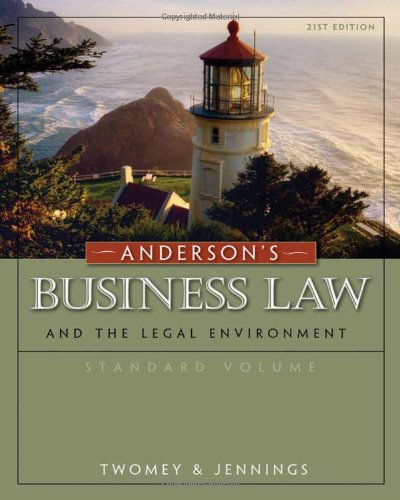Test Bank for Anderson’s Business Law And The Legal Environment 21st Edition by David P. Twomey
Digital item No Waiting Time Instant DownloadISBN-10 : 0324786689ISBN-13 : 978-0324786682Publisher : South-Western College/West; 21st editionDavid P. Twomey, Marianne M. Jennings
In Stock
Original price was: $55.00.$35.00Current price is: $35.00.
Test Bank for Anderson’s Business Law And The Legal Environment 21st Edition by David P. Twomey
Table of Contents
Test Bank for Anderson’s Business Law and the Legal Environment, 21st Edition by David P. Twomey
The “Test Bank for Anderson’s Business Law and the Legal Environment, 21st Edition” by David P. Twomey, Marianne M. Jennings, and Stephanie M. Greene is an essential educational resource designed to support educators and students in mastering the principles and practices of business law. This comprehensive test bank complements the textbook by providing a wide array of questions that assess and reinforce understanding of key concepts in business law and the legal environment. Here is a detailed overview of the components and benefits of this test bank:
Overview of Test Bank Content
- Chapter-by-Chapter Organization
- The test bank is meticulously organized to align with each chapter of the textbook, ensuring comprehensive coverage of all critical topics. This structure facilitates easy integration into the curriculum and enables targeted assessments.
- Types of Questions
- Multiple-Choice Questions (MCQs): Assess a broad spectrum of knowledge from basic recall to complex application and critical thinking. Each question includes well-crafted distractors to challenge students’ understanding.
- True/False Questions: Evaluate students’ ability to differentiate between correct and incorrect statements, reinforcing factual knowledge and addressing common misconceptions.
- Fill-in-the-Blank Questions: Focus on recalling specific details such as key terms, legal concepts, and important principles, testing students’ memory and understanding.
- Short Answer Questions: Require detailed yet concise responses, evaluating students’ ability to explain business law concepts clearly and accurately.
- Essay Questions: Assess students’ ability to synthesize and articulate complex ideas, demonstrating a deep understanding of business law principles and their applications.
- Case Studies and Scenarios: Real-world scenarios and case studies help students apply theoretical knowledge to practical situations, enhancing their critical thinking and problem-solving skills.
- Difficulty Levels
- Questions are categorized by difficulty to provide a range of challenges and assess students’ proficiency at different levels, including:
- Basic: Testing foundational knowledge and comprehension.
- Intermediate: Requiring application of knowledge to practical legal scenarios.
- Advanced: Involving critical thinking, analysis, and synthesis of complex legal concepts.
- Questions are categorized by difficulty to provide a range of challenges and assess students’ proficiency at different levels, including:
- Core Focus Areas
- Introduction to Business Law: Questions covering the basic principles and scope of business law, including the roles and responsibilities of businesses in the legal environment.
- Contracts: Detailed coverage of contract law, including formation, performance, breach, and remedies.
- Sales and Lease Contracts: Assessing knowledge of the Uniform Commercial Code (UCC) and its application to sales and lease transactions.
- Negotiable Instruments: Questions on the creation, transfer, and enforcement of negotiable instruments.
- Agency and Employment Law: Focus on the principles of agency, employment relationships, and employment laws.
- Business Organizations: Examining the different forms of business organizations, including sole proprietorships, partnerships, corporations, and limited liability companies (LLCs).
- Government Regulation: Assessing understanding of government regulation of business, including antitrust laws, securities regulation, and environmental laws.
- Property Law: Questions on real, personal, and intellectual property law.
- Credit and Bankruptcy: Coverage of credit, secured transactions, and bankruptcy laws.
- International Business Law: Questions on international legal issues affecting businesses, including international trade, contracts, and dispute resolution.
- Ethics and Social Responsibility: Evaluating the ethical considerations and social responsibilities of businesses in the legal environment.
- Cyber Law and E-Commerce: Questions on legal issues related to digital transactions, data protection, and online business practices.
- Alignment with Learning Objectives
- Each question in the test bank is aligned with the learning objectives outlined in the textbook, ensuring that assessments are relevant and targeted towards achieving the intended educational outcomes. This alignment helps in accurately measuring students’ progress and comprehension.
- Educational Support and Utility
- For educators, the test bank provides a comprehensive resource for creating quizzes, exams, and other assessments. It simplifies the process of test creation and ensures consistency and alignment with the curriculum.
- For students, the test bank serves as a valuable tool for self-assessment and study, helping them identify areas of strength and weakness and focus their efforts on areas needing improvement.
Benefits of Using the Test Bank
- Enhanced Learning and Retention
- The diverse range of question types and difficulty levels helps reinforce learning through varied and repeated exposure to key concepts, enhancing retention and understanding.
- Preparation for Real-World Applications
- By focusing on real-world scenarios and practical applications, the test bank prepares students for the practical aspects of business law, ensuring they are ready to apply their knowledge in professional settings.
- Comprehensive Assessment
- The test bank allows for thorough and multi-faceted evaluation of students’ knowledge and skills, from basic understanding to advanced application, ensuring a well-rounded educational experience.
- Efficient Teaching Resource
- For educators, the test bank simplifies the process of creating assessments, providing a consistent and reliable tool for evaluating students’ progress and readiness for advanced studies in business law.
Conclusion
The “Test Bank for Anderson’s Business Law and the Legal Environment, 21st Edition” by David P. Twomey, Marianne M. Jennings, and Stephanie M. Greene is an essential resource for business law education. It provides structured, comprehensive, and versatile tools for assessing and enhancing students’ knowledge and skills in business law. By aligning closely with the textbook and emphasizing real-world application, the test bank supports the development of competent, confident professionals ready to excel in their understanding and application of business law principles.


Reviews
There are no reviews yet.